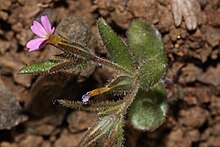
The Polemoniaceae are a family of flowering plants consisting of about 27 genera with 270–400 species of annuals and perennials native to the Northern Hemisphere and South America, with the center of diversity in western North America.

Agalinis acuta is an annual hemiparasitic plant native to Maryland, Massachusetts, Rhode Island, Connecticut, and Long Island, New York. Common names include sandplain gerardia and sandplain false foxglove. It is one of about 70 species that comprise genus Agalinis. It currently resides within the family Orobanchaceae, but historically was aligned with members of the Scrophulariaceae. This was one of several re-alignments that were the consequence of the disintegration of the Scrophulariaceae as the result of conclusions based on molecular phylogeny data from the chloroplast genome. While historically regarded as a separate species, molecular phylogenetic data indicates that Agalinis acuta should be consolidated as part of the species Agalinis decemloba.

Gilia brecciarum is an annual flowering plant in the phlox family (Polemoniaceae), known by the common name Nevada gilia or break gilia.
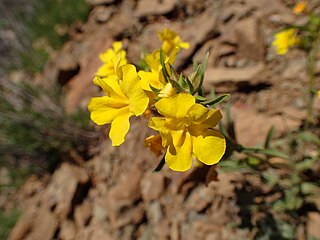
Diplacus brevipes is a species of monkeyflower known by the common name widethroat yellow monkeyflower. It was formerly known as Mimulus brevipes.

Diplacus fremontii is a species of monkeyflower known by the common name Frémont's monkeyflower. It is native to California and Baja California, where it grows in mountain and desert habitat, especially moist or disturbed areas. It was formerly known as Mimulus fremontii.
Erythranthe inflatula, synonyms Mimulus inflatulus and Mimulus evanescens, is a rare species of monkeyflower known by the common name disappearing monkeyflower. It is native to the western United States, where it is known from about ten locations in and around the Great Basin within the states of Idaho, Oregon, and California; it is also found in Nevada. Specimens of the plant had been catalogued as Mimulus breviflorus, but on further examination it was evident that they were a separate, unclassified species; this was described to science in 1995. It is thought that the plant may have evolved via hybridization between Erythranthe breviflora and Erythranthe latidens, or that it evolved from E. latidens and then into E. breviflora.

Diplacus pictus is a species of monkeyflower known by the common name calico monkeyflower.
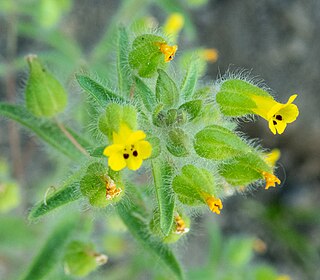
Mimetanthe is a genus of flowering plants in the family Phrymaceae. It has only one species, Mimetanthe pilosa, synonym Mimulus pilosus, known by the common names false monkeyflower and downy mimetanthe. It is native to the western United States and Baja California, where it grows in moist and disturbed habitat types. This plant is different enough from other monkeyflowers that it is treated in its own monotypic genus, Mimetanthe, or it may be retained in Mimulus.
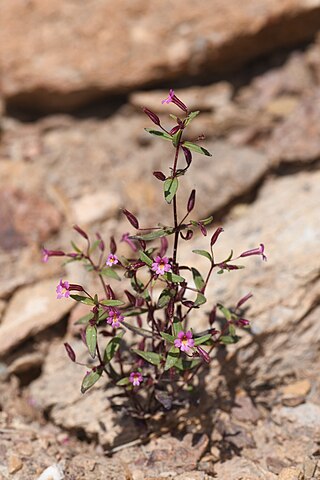
Erythranthe rubella is a species of monkeyflower known by the common name little redstem monkeyflower. It was formerly known as Mimulus rubellus.

Erythranthe shevockii is a rare species of monkeyflower known by the common name Kelso Creek monkeyflower. It was formerly known as Mimulus shevockii.

Erythranthe tilingii is a species of monkeyflower known by the common name Tiling's monkeyflower. It was formerly known as Mimulus tilingii.

Diplacus tricolor is a species of monkeyflower known by the common name tricolor monkeyflower. It is native to Oregon and California. It grows in seasonally wet habitats such as meadows and vernal pools, including those in the San Joaquin Valley and near north coast oak woodlands. It was formerly known as Mimulus tricolor.
Navarretia jepsonii is an uncommon species of flowering plant in the phlox family known by the common name Jepson's pincushionplant, or Jepson's navarretia.

Phlox diffusa is a species of phlox known by the common name spreading phlox. It is native to western North America from British Columbia to the southwestern United States to the Dakotas, where it grows in many types of habitat, including rocky, high elevation mountain slopes. It is a very compact mat-forming perennial herb growing in cushions or patches of short, decumbent stems. The linear, lance-shaped, or needle-like leaves are no more than 1.5 centimeters long and are oppositely arranged in bundles on the short stems. The inflorescence is a solitary tubular flower around a centimeter long. It has a flat white or pale pink or blue corolla with five lobes each just under a centimeter in length.
Phlox dolichantha is a species of phlox known by the common name Big Bear Valley phlox. It is endemic to San Bernardino County, California, where it is limited to the area around Big Bear Lake in the San Bernardino Mountains. It grows in forests and the unique local pebble plain habitat. It occurs at elevations over 2000 meters. It is an erect, branching perennial herb growing up to 30 centimeters tall. The linear or narrowly lance-shaped leaves are 2 to 5 centimeters long and are oppositely arranged on the slender stems. The inflorescence is made up of one or more showy flowers at the tip of the stem. Each flower has a very slender tubular throat up to 5 centimeters long which can be white, pink, or lavender.
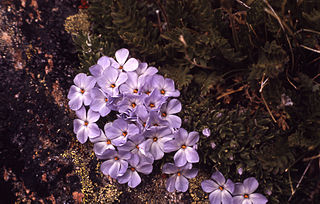
Phlox pulvinata is a species of phlox known by the common name cushion phlox. It is native to the western United States where it grows in mountain and plateau habitat, in rocky subalpine and alpine climates, including exposed tundra habitat. It is a perennial herb taking a flat, dense, cushionlike form on the ground. Its very short stems are lined with hair-fringed lance-shaped leaves each no more than one centimeter long. The plant is among the first to flower in the spring in many areas. It blooms densely, forming carpets of flowers. Each white to pale pink flower has a tubular throat up to one centimeter long and a flat five-lobed corolla.
Gilia yorkii is a rare species of flowering plant in the phlox family known by the common names Boyden Cave gilia and monarch gilia. It is endemic to Fresno County, California, where it is known from only one location in the southern Sierra Nevada. This plant grows in rock cracks in the limestone cliffs and outcrops in the chaparral and woodlands of the canyon.
Navarretia ojaiensis is a rare species of flowering plant in the phlox family known by the common name Ojai navarretia.
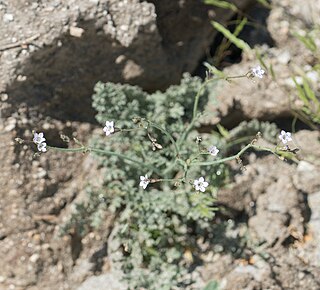
Saltugilia latimeri is an uncommon species of flowering plant in the phlox family known by the common name Latimer's woodland gilia. It is endemic to California, where it is known from several scattered occurrences in the western Mojave Desert and outlying areas to the north. It occurs in dry rocky and sandy desert canyons. It was first described as a species in 2001.

Saltugilia is a genus of flowering plants in the phlox family, Polemoniaceae. They are known commonly as woodland gilias. There are four species. Two are endemic to California in the United States, and the distributions of the other two extend into Baja California in Mexico.
